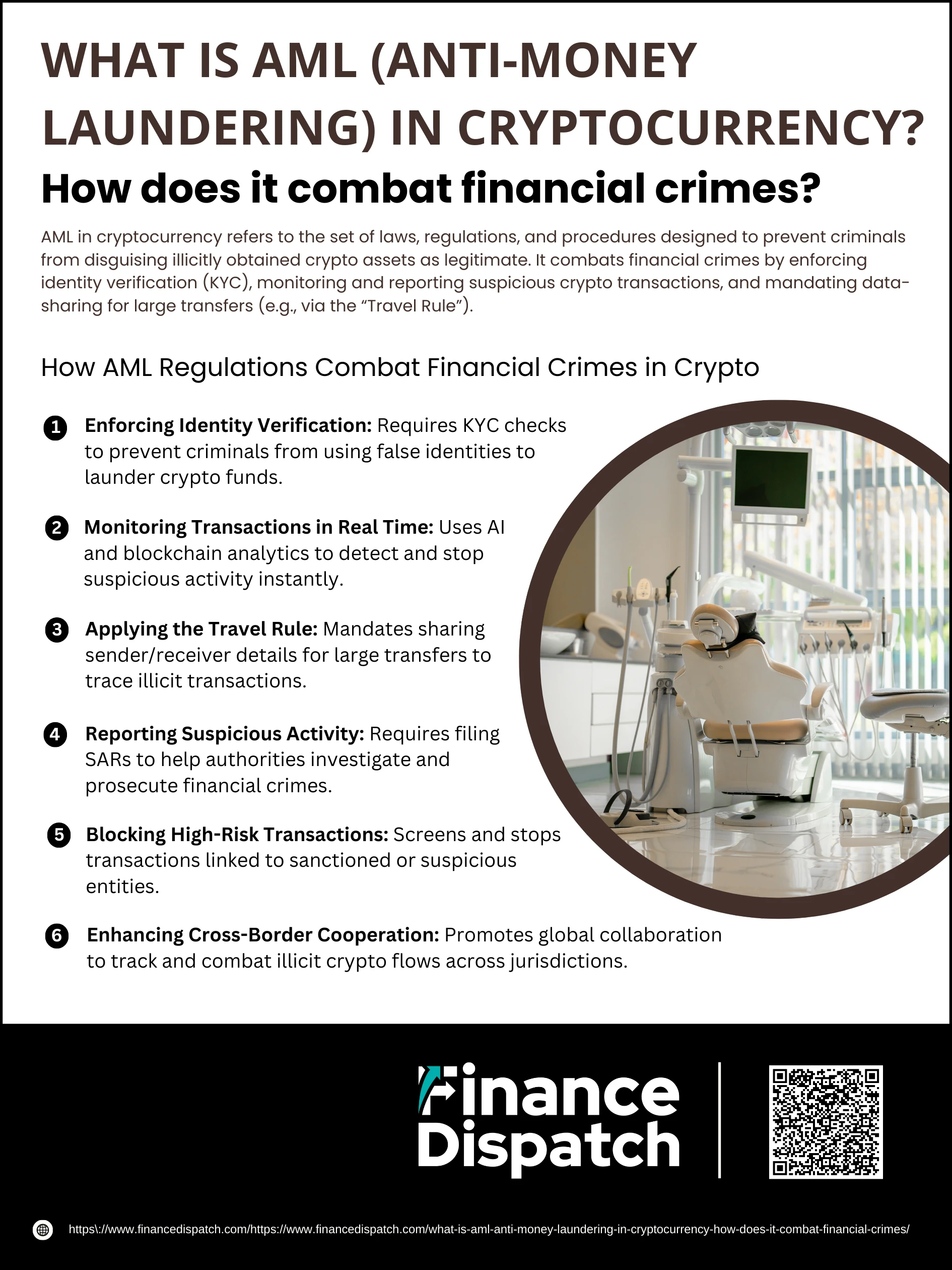In the fast-evolving world of digital currencies, the same qualities that make cryptocurrency revolutionary—decentralization, global accessibility, and rapid transactions—also make it attractive to criminals seeking to disguise illicit funds. Anti-Money Laundering (AML) in cryptocurrency refers to a framework of laws, regulations, and practices designed to detect, prevent, and report the movement of illegally obtained assets through crypto platforms. As billions of dollars are laundered through virtual assets each year, AML measures have become essential not only for meeting legal obligations but also for safeguarding market integrity, protecting investors, and preserving trust in the blockchain ecosystem. This article explores what AML means in the context of cryptocurrency and how it plays a critical role in combating financial crimes.
What is Anti-Money Laundering (AML) in Cryptocurrency?
Anti-Money Laundering (AML) in cryptocurrency refers to the set of regulations, policies, and technologies aimed at preventing criminals from using digital assets to disguise the origins of illicit funds. In traditional finance, AML focuses on detecting suspicious activities like money laundering, terrorist financing, and tax evasion; in the crypto space, these same principles apply but require tailored approaches due to the decentralized and pseudonymous nature of blockchain transactions. AML in cryptocurrency typically involves measures such as Know Your Customer (KYC) verification, Customer Due Diligence (CDD), transaction monitoring, and suspicious activity reporting. By combining these practices with advanced blockchain analytics, crypto exchanges, wallet providers, and other Virtual Asset Service Providers (VASPs) can identify high-risk transactions, trace fund flows, and ensure compliance with global regulatory standards.
Key Components of AML in Cryptocurrency
Anti-Money Laundering (AML) in cryptocurrency is built on a structured framework designed to detect and prevent the misuse of digital assets for illicit activities. Because of the unique risks posed by pseudonymous transactions and global accessibility, AML in crypto relies on specific processes that combine traditional financial safeguards with blockchain-focused tools. These components work together to verify user identities, monitor activity, and report suspicious behavior to relevant authorities.
1. Know Your Customer (KYC): Verifying user identities through government-issued documents, proof of address, and biometric checks to ensure legitimate participation.
2. Customer Due Diligence (CDD): Assessing each customer’s risk profile and applying enhanced measures for high-risk individuals or entities.
3. Transaction Monitoring: Continuously analyzing blockchain activity for unusual patterns, large transfers, or transactions linked to suspicious addresses.
4. Suspicious Activity Reporting (SARs): Filing official reports with regulators when potentially illicit transactions are detected.
5. Record-Keeping and Audit Trails: Maintaining detailed transaction logs and customer records to enable investigations and regulatory audits.
6. Blockchain Analytics: Using specialized tools to trace fund flows, identify linked wallets, and detect laundering techniques like mixing or tumbling services.
 How AML Regulations Combat Financial Crimes in Crypto
How AML Regulations Combat Financial Crimes in Crypto
Anti-Money Laundering (AML) regulations in cryptocurrency are designed to tackle the risks that come with decentralized, borderless, and often pseudonymous transactions. Criminals may use digital assets to move illicit funds quickly across borders, making it challenging for authorities to trace the source. By implementing AML measures such as KYC verification, transaction monitoring, and the Travel Rule, regulators and crypto businesses create multiple barriers against illegal activity. These safeguards not only protect the financial ecosystem but also foster trust among investors, businesses, and regulators.
Ways AML Regulations Combat Financial Crimes:
1. Enforcing Identity Verification
AML regulations require cryptocurrency exchanges, custodial wallet providers, and other Virtual Asset Service Providers (VASPs) to verify the identities of their customers before allowing transactions. This is achieved through Know Your Customer (KYC) procedures, which collect and authenticate documents like passports, driver’s licenses, and proof of address. By removing anonymity at the onboarding stage, regulators make it much harder for criminals to open accounts under false identities and use them for laundering illicit funds.
2. Monitoring Transactions in Real Time
Modern AML frameworks use artificial intelligence (AI) and blockchain analytics to analyze transaction data as it happens. These systems look for red flags such as sudden large transfers, rapid fund movement between wallets, or transactions with addresses previously linked to illegal activity. Real-time monitoring allows platforms to freeze suspicious activity immediately, preventing criminals from quickly moving or withdrawing illicit funds.
3. Applying the Travel Rule
The Travel Rule, issued by the Financial Action Task Force (FATF), requires VASPs to share sender and recipient information for cryptocurrency transfers above a certain threshold (often $1,000 or €1,000). This rule ensures that both sides of a transaction are documented, making it easier for authorities to trace funds if they are later linked to criminal activity. It closes gaps that criminals could exploit by moving money across platforms with minimal oversight.
4. Reporting Suspicious Activity
AML regulations mandate that crypto businesses file Suspicious Activity Reports (SARs) with financial intelligence units or regulators whenever they detect potentially illicit transactions. These reports detail the nature of the suspicious activity, the parties involved, and supporting transaction data. By centralizing this information with enforcement agencies, SARs help build stronger cases against money launderers, terrorist financiers, and other financial criminals.
5. Blocking High-Risk Transactions
AML compliance tools can automatically screen transactions against global watchlists, sanctions lists, and blacklists of known criminal wallets. If a transaction involves a sanctioned jurisdiction, a flagged wallet, or a politically exposed person (PEP) with a history of corruption, the system can block it before completion. This prevents illicit funds from entering or leaving compliant platforms, cutting off one of the most common pathways for laundering money in crypto.
6. Enhancing Cross-Border Cooperation
Since cryptocurrencies can move instantly across borders, effective AML enforcement relies on international collaboration. Organizations like the FATF set global AML standards that member countries adopt into their national laws. Through shared databases, intelligence sharing, and joint investigations, regulators can track illicit crypto transactions that cross multiple jurisdictions. This cooperation makes it significantly harder for criminals to hide behind fragmented national regulations.
Common Financial Crimes Prevented by AML in Cryptocurrency
Anti-Money Laundering (AML) measures in cryptocurrency are designed to address the wide range of financial crimes that exploit the speed, borderless nature, and pseudonymity of blockchain transactions. Without AML safeguards, criminals could use crypto to disguise the origins of illicit funds, finance terrorism, commit large-scale fraud, or engage in market manipulation. By combining strict identity verification, continuous transaction monitoring, and global information-sharing standards, AML frameworks help disrupt these illegal activities and protect the integrity of the digital asset ecosystem.
| Financial Crime | Description | How AML Helps Prevent It |
| Money Laundering | Disguising illicit funds as legitimate assets through complex transactions. | KYC, CDD, blockchain analytics, and reporting suspicious activity make it harder to hide the origins of funds. |
| Terrorist Financing | Providing funds to individuals or groups engaged in terrorism. | Screening against global watchlists, Travel Rule compliance, and cross-border intelligence sharing block high-risk transfers. |
| Fraud and Scams | Schemes like Ponzi scams, phishing, and fake ICOs to steal funds from victims. | Identity verification, transaction monitoring, and AML fraud detection tools flag suspicious activity early. |
| Market Manipulation | Artificially inflating or deflating asset prices (pump-and-dump schemes). | Monitoring large trades, unusual patterns, and coordinated activity helps identify and disrupt manipulation. |
| Sanctions Evasion | Moving funds through crypto to bypass international sanctions. | Sanction list screening, jurisdiction risk scoring, and transaction blocking prevent prohibited transfers. |
| Dark Web Transactions | Using crypto to buy or sell illegal goods and services. | Blockchain forensics trace payments linked to darknet marketplaces and flag associated wallets. |
Challenges of Implementing AML in Crypto
While Anti-Money Laundering (AML) is essential for securing the cryptocurrency ecosystem, implementing it effectively comes with significant challenges. The decentralized nature of blockchain, the global scope of transactions, and the privacy features of certain digital assets make it harder to apply traditional compliance frameworks. Crypto businesses must balance user privacy, operational efficiency, and regulatory obligations while addressing evolving threats from sophisticated financial criminals.
Key Challenges:
1. Pseudonymity of Wallet Addresses: Transactions are visible on the blockchain, but wallet owners’ real identities are not directly linked without KYC.
2. Cross-Border Nature of Transactions: Crypto moves instantly across jurisdictions with varying AML laws, complicating enforcement.
3. Decentralized Exchanges (DEXs): Lack of central authority makes enforcing AML measures and conducting KYC more difficult.
4. Privacy Coins and Technologies: Assets like Monero and Zcash use advanced privacy features that make tracing transactions challenging.
5. Mixing and Tumbling Services: These tools blend funds from multiple sources, obscuring the trail of illicit transactions.
6. Lack of Global Regulatory Standardization: Inconsistent rules across countries create loopholes for criminals to exploit.
7. User Resistance to KYC/AML: Some crypto users view compliance as intrusive and against decentralization principles.
8. Emerging Threat Vectors: New technologies, such as DeFi protocols and zero-knowledge rollups, can be exploited for money laundering.
The Future of AML in Cryptocurrency
The future of Anti-Money Laundering (AML) in cryptocurrency will be shaped by a combination of stricter regulations, advanced technology, and greater international cooperation. As digital assets become more mainstream, regulators are expected to expand existing frameworks to cover emerging areas such as decentralized finance (DeFi), non-fungible tokens (NFTs), and privacy-focused coins. Artificial intelligence, machine learning, and blockchain analytics will play a central role in real-time transaction monitoring, enabling faster detection of suspicious activity across multiple networks. Global alignment through organizations like the Financial Action Task Force (FATF) will help close regulatory gaps, while automated compliance solutions will allow crypto businesses to meet complex requirements without sacrificing efficiency or user experience. Ultimately, the future of AML in cryptocurrency will hinge on balancing innovation with robust safeguards to maintain trust, security, and market integrity.
Conclusion
Anti-Money Laundering (AML) in cryptocurrency is no longer an optional compliance measure—it is a critical foundation for protecting the integrity of the digital asset ecosystem. By combining identity verification, transaction monitoring, and global regulatory cooperation, AML frameworks help prevent financial crimes such as money laundering, terrorist financing, and fraud. While challenges remain due to the decentralized and borderless nature of blockchain, advancements in AI-driven analytics, blockchain forensics, and international regulatory alignment are making compliance more effective. For crypto businesses, embracing robust AML practices not only ensures legal compliance but also builds trust with users, investors, and regulators, paving the way for a safer, more transparent, and sustainable future for the industry.



